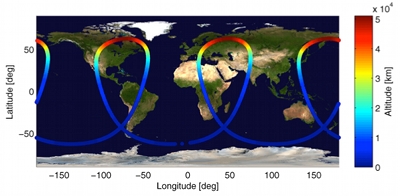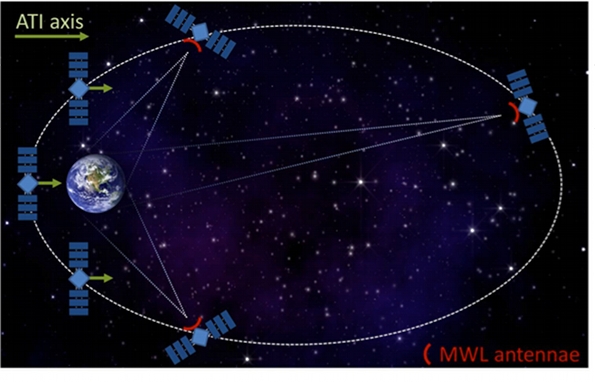Mission operations
Orbit
The nature of the tests conducted by STE-QUEST requires a highly elliptic orbit with:
- Large gravitational accelerations around perigee;
- Low gravity gradient and non-gravitational disturbances;
- Long common-view contacts of the spacecraft from ground stations in different continents;
- Large variations of the gravitational potential between apogee and perigee.
A highly elliptic orbit ensures sufficient measurement time for the differential atom interferometer at altitudes below 3000 km as well as long common-view durations from the science link terminals on the ground and large variations of the gravitational potential.
The orbit has a semi-major axis of about
Launch is planned with Soyuz Fregat from Kourou in French Guiana. After a drift phase, the spacecraft is placed into the final orbit using the Fregat upper stage, which separates and de-orbits after successful insertion. Small corrections are performed on spacecraft resources.
After the five years of mission duration, with one year of margin, the spacecraft is de-orbited by its on-board propulsion system to ensure leaving the protected zones in compliance with the space debris policy. The spacecraft would naturally de-orbit, but a safe re-entry cannot be guaranteed without controlled manoeuvres.
 |
.jpg) |
|
(Left) Ground track for the STE-QUEST orbit. (Right) Perigee altitude variation over the mission duration. The red segment corresponds to the commissioning phase, the black segment covers the routine science phase and an eventual mission extension. Credit: ESA |
|
Measurement Strategy
In this section we describe the data analysis steps leading to the final scientific products of the mission:
- Differential acceleration measurements by atom interferometry and evaluation of the Eötvös parameter;
- Clock comparison measurements.
The atom interferometer will primarily perform differential acceleration measurements while the spacecraft is around perigee (spacecraft altitude below 3000 kilometres), thus maximising the signal-to-noise ratio of a possible violation of the Weak Equivalence Principle.
The on-board link will compare the ground clocks connected to the STE-QUEST global network, measuring the periodic effect of the gravitational red-shift induced by the Sun and the Moon.
The control on spurious accelerations and spacecraft rotations at the differential atom interferometer requires the STE-QUEST spacecraft to be inertially pointed when orbiting around perigee, at altitudes below 3000 km. The operation of the science link requires the on-board antennae to be pointed towards nadir for a large fraction of the STE-QUEST orbit and in particular around apogee. The two modes described above, determine the attitude motion of the STE-QUEST spacecraft.
 |
|
The STE-QUEST spacecraft attitude along the orbit. Credit: ESA |
Ground Segment
The STE-QUEST ground segment is composed of:
- the Mission Operations Centre, which is responsible for performing all spacecraft, payload, and ground segment related operations and receiving, processing, storing and distributing the complete payload telemetry.
- the Science Operations Centre, which is responsible for the definition of the STE-QUEST scientific operations (both payload and ground segment), for the analysis and processing of the science data, for the generation and archiving of mission data products.
-
a Distributed Network of Users' Ground Stations which is made up of scientific institutes participating in STE-QUEST and responsible for
- comparing high-performance atomic clocks on ground with the signals from the STE-QUEST clock in space;
- analysing STE-QUEST scientific data.
Close monitoring of the spacecraft will be necessary during the on-orbit characterisation phase which is expected to last for the first 6 months of the mission.
The payload will be operated on the basis of scheduled sequences of commands which will be uploaded to the spacecraft and executed on board
The estimated data volume is compatible with small ESOC ground stations.
